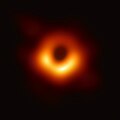Galactic Center GeV excess

The Galactic Center GeV Excess (GCE) is an unexpected surplus of gamma-ray radiation coming from the center of the Milky Way Galaxy. This approximately spherical source of radiation was first detected in 2009[1][2] by the Large Area Telescope of the Fermi Gamma-ray Space Telescope and is unexplained by direct observation of possible sources.[3] Two percent of the gamma ray radiation in a 30° radius circle around the Galactic Center is attributed to the GCE. As of 2025[update], this excessive (and diffused) gamma-ray radiation is not well understood by astronomers.[4][5][6][7][8]
Some astronomers argue that self-annihilating dark matter (which is not otherwise known to radiate) may be the cause of the GCE. This would also explain the excess diffuse microwave glow of the galactic center that had been discovered previously by the WMAP satellite.[8] Other astronomers prefer a population of pulsars (which have not been observed) as the source of the gamma-ray excess.[9][3]
Astronomers have suggested that self-annihilating dark matter may be a dominant contributor to the GCE, based on analysis using non-Poissonian template fitting statistical methods,[5] wavelet methods,[7] and studies by other astronomers may support this idea.[10][11] More recently, in August 2020, other astronomers have reported that self-annihilating dark matter may not be the explanation for the GCE after all.[12][13] Other hypotheses include ties to a yet unseen population of millisecond pulsars[14][15] or young pulsars, burst events, the stellar population of the galactic bulge,[16] or the Milky Way's central supermassive black hole.[17]
A 2025 study, which simulated the evolution of the Milky Way to obtain the likely shape of the galaxy's dark matter halo, concluded that self-annihilation of dark matter WIMPs and a population of fast-rotating old pulsars remain equally plausible explanations of the GCE. Upcoming high-energy observations such as those of the Cherenkov Telescope Array Observatory may be able to resolve the matter.[8]
See also
[edit]- Galactic Center – Rotational center of the Milky Way galaxy
- Gamma-ray astronomy – Observational astronomy performed with gamma rays
- List of unsolved problems in astronomy
References
[edit]- ^ Goodenough, Lisa; Hooper, Dan (11 November 2009). "Possible Evidence For Dark Matter Annihilation In The Inner Milky Way From The Fermi Gamma Ray Space Telescope". arXiv:0910.2998 [hep-ph].
- ^ Wolchover, Natalie (3 March 2014). "Case for Dark Matter Signal Strengthens". Quanta Magazine. Retrieved 12 August 2021.
- ^ a b Cho, Adrian (12 November 2019). "Physicists revive hunt for dark matter in the heart of the Milky Way". Science | AAAS. Retrieved 31 March 2020.
- ^ Starr, Michelle (30 April 2019). "Something's Glowing at The Heart of Our Galaxy, But It May Not Be What We Thought". ScienceAlert.com. Retrieved 30 April 2019.
- ^ a b Leane, Rebecca K. & Slatyer, Tracy R. (17 April 2019). "Dark Matter Strikes Back at the Galactic Center". Phys. Rev. Lett. 123 (24) 241101. arXiv:1904.08430. doi:10.1103/PhysRevLett.123.241101. PMID 31922851. S2CID 210150636.
- ^ Fadelli, Ingrid (14 July 2020). "Could recently spotted dim point sources explain the galactic center excess (GCE)?". Phys.org. Retrieved 14 July 2020.
- ^ a b Zhong, Yi-Ming; McDermott, Samuel D.; Cholis, Ilias & Fox, Patrick J. (2020). "Testing the Sensitivity of the Galactic Center Excess to the Point Source Mask". Phys. Rev. Lett. 124 (23) 231103. arXiv:1911.12369. Bibcode:2020PhRvL.124w1103Z. doi:10.1103/PhysRevLett.124.231103. PMID 32603155. S2CID 208512856.
- ^ a b c Muru, Moorits Mihkel; Silk, Joseph; Libeskind, Noam I.; Gottlöber, Stefan; Hoffman, Yehuda (16 October 2025). "Fermi-LAT Galactic Center Excess Morphology of Dark Matter in Simulations of the Milky Way Galaxy". Physical Review Letters. 135 (16): 161005. arXiv:2508.06314. doi:10.1103/g9qz-h8wd.
- ^ "Is there dark matter at the center of the Milky Way?". MIT News. 10 December 2019. Retrieved 4 May 2023.
- ^ Cuoco, Alessandro; et al. (4 March 2019). "Scrutinizing the evidence for dark matter in cosmic-ray antiprotons". Physical Review D. 99 (10) 103014. arXiv:1903.01472. Bibcode:2019PhRvD..99j3014C. doi:10.1103/PhysRevD.99.103014. S2CID 119333152.
- ^ Cholis, Ilias; et al. (6 March 2019). "A Robust Excess in the Cosmic-Ray Antiproton Spectrum: Implications for Annihilating Dark Matter". Physical Review D. 99 (10) 103026. arXiv:1903.02549. Bibcode:2019PhRvD..99j3026C. doi:10.1103/PhysRevD.99.103026. S2CID 118857451.
- ^ Starr, Michelle (28 August 2020). "There's a Strange Glow in The Centre of Our Galaxy, And It's Not What We Thought It Was". ScienceAlert.com. Retrieved 28 August 2020.
- ^ Abazajian, Kevork N.; et al. (4 August 2020). "Strong constraints on thermal relic dark matter from Fermi-LAT observations of the Galactic Center". Physical Review D. 102 (43012) 043012. arXiv:2003.10416. Bibcode:2020PhRvD.102d3012A. doi:10.1103/PhysRevD.102.043012.
- ^ Bartels, Richard; et al. (February 2016). "Strong Support for the Millisecond Pulsar Origin of the Galactic Center GeV Excess". Physical Review Letters. 116 (5). 051102. arXiv:1506.05104. Bibcode:2016PhRvL.116e1102B. doi:10.1103/PhysRevLett.116.051102. PMID 26894696. S2CID 217518922.
- ^ Gautam, Anuj; Crocker, Roland M.; Ferrario, Lilia; Ruiter, Ashley J.; Ploeg, Harrison; Gordon, Chris; Macias, Oscar (28 April 2022). "Millisecond pulsars from accretion-induced collapse as the origin of the Galactic Centre gamma-ray excess signal". Nature Astronomy. 6 (6): 703–707. arXiv:2106.00222. Bibcode:2022NatAs...6..703G. doi:10.1038/s41550-022-01658-3. ISSN 2397-3366. S2CID 235265843.
- ^ Macias, Oscar; et al. (12 March 2018). "Galactic bulge preferred over dark matter for the Galactic centre gamma-ray excess". Nature Astronomy. 2 (5): 387–392. arXiv:1611.06644. Bibcode:2018NatAs...2..387M. doi:10.1038/s41550-018-0414-3. S2CID 54936254.
- ^ Hooper, Dan & Goodenough, Lisa (21 March 2011). "Dark matter annihilation in the Galactic Center as seen by the Fermi Gamma Ray Space Telescope". Physics Letters B. 697 (5): 412–428. arXiv:1010.2752. Bibcode:2011PhLB..697..412H. doi:10.1016/j.physletb.2011.02.029. S2CID 118446838.
Further reading
[edit]- Ackermann, M.; et al. (May 2017). "The Fermi Galactic Center GeV Excess and Implications for Dark Matter". The Astrophysical Journal. 840 (1). 43. arXiv:1704.03910. Bibcode:2017ApJ...840...43A. doi:10.3847/1538-4357/aa6cab. S2CID 119481146.
- Shang, Liangliang; et al. (May 2018). "Interpretations of galactic center gamma-ray excess confronting the PandaX-II constraints on dark matter-neutron spin-dependent scatterings in the NMSSM". European Physical Journal C. 78 (5). 390. arXiv:1804.08797. Bibcode:2018EPJC...78..390S. doi:10.1140/epjc/s10052-018-5827-8. S2CID 55864561.


